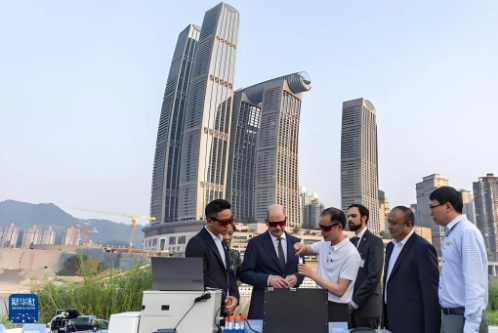On April 14th, 2024, Professor Wei Wei, Xu Yi, Shunbo, and Chen Li from the School of Optoelectronic Engineering at Chongqing University conducted on-site exchanges with the visiting German Chancellor Olaf Scholz at the Jiangtan Park in Jiangbei District, revolving around the most recent relevant research achievements of the Sino-German cooperation project on water quality monitoring.
To begin with, Professor Xu Yi introduced to Chancellor Olaf Scholz in detail the series of microfluidic sensing chips developed by the project team, including those with integrated separation and enrichment functions, electrical sensing detection, and multi-channel fluorescence detection. She also presented the prototype devices such as the microfluidic Raman detection system, fluorescence quenching metal ion detector, and charged particle fluorescence detector. On-site demonstrations were conducted, showing the rapid detection process of heavy metal ion samples using the fluorescence quenching metal ion detector and the rapid detection of organic pollutant samples using the charged particle fluorescence detector.
During the visit, Chancellor Scholz expressed the keen interest in operating the instruments and inquired about the progress of the mutual cooperation. He highly recognized the cooperation between China and Germany on environmental protection projects, stating that "the relevant research achievements of this project are very meaningful for protecting the ecological environment and biodiversity." He expressed his sincere hope for strengthening cooperation between the two sides.
The water quality monitoring project relies on the International Joint Research Center for Micro/Nano Systems and New Materials Technology at the School of Optoelectronic Engineering of Chongqing University. With the support of the Chongqing Science and Technology Bureau and the Ministry of German Environment and Agriculture of Saxony, China and Germany have jointly carried out research and development on efficient detection technologies and equipment for water environmental pollutants. The goal is to establish a multi-parameter water quality field detection system and instrumentation with high detection efficiency and fast detection speed for heavy metal ions, microorganisms, organic pollutant molecules, and more. This system aims to provide technical support for early water pollution warning and prevention. In the future, both sides will further deepen cooperation and strive for the early practical application of relevant scientific research achievements.
